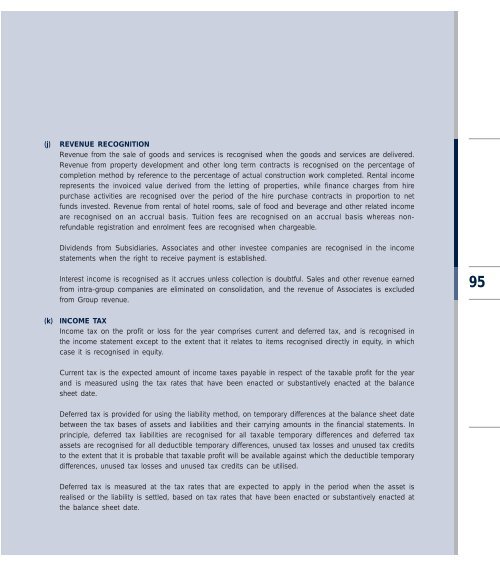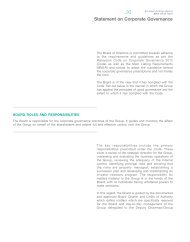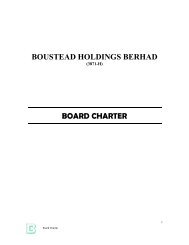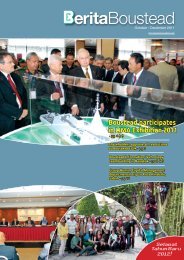to download - Boustead Holdings Berhad
to download - Boustead Holdings Berhad
to download - Boustead Holdings Berhad
You also want an ePaper? Increase the reach of your titles
YUMPU automatically turns print PDFs into web optimized ePapers that Google loves.
(j) REVENUE RECOGNITION<br />
Revenue from the sale of goods and services is recognised when the goods and services are delivered.<br />
Revenue from property development and other long term contracts is recognised on the percentage of<br />
completion method by reference <strong>to</strong> the percentage of actual construction work completed. Rental income<br />
represents the invoiced value derived from the letting of properties, while finance charges from hire<br />
purchase activities are recognised over the period of the hire purchase contracts in proportion <strong>to</strong> net<br />
funds invested. Revenue from rental of hotel rooms, sale of food and beverage and other related income<br />
are recognised on an accrual basis. Tuition fees are recognised on an accrual basis whereas nonrefundable<br />
registration and enrolment fees are recognised when chargeable.<br />
Dividends from Subsidiaries, Associates and other investee companies are recognised in the income<br />
statements when the right <strong>to</strong> receive payment is established.<br />
Interest income is recognised as it accrues unless collection is doubtful. Sales and other revenue earned<br />
from intra-group companies are eliminated on consolidation, and the revenue of Associates is excluded<br />
from Group revenue.<br />
(k) INCOME TAX<br />
Income tax on the profit or loss for the year comprises current and deferred tax, and is recognised in<br />
the income statement except <strong>to</strong> the extent that it relates <strong>to</strong> items recognised directly in equity, in which<br />
case it is recognised in equity.<br />
Current tax is the expected amount of income taxes payable in respect of the taxable profit for the year<br />
and is measured using the tax rates that have been enacted or substantively enacted at the balance<br />
sheet date.<br />
Deferred tax is provided for using the liability method, on temporary differences at the balance sheet date<br />
between the tax bases of assets and liabilities and their carrying amounts in the financial statements. In<br />
principle, deferred tax liabilities are recognised for all taxable temporary differences and deferred tax<br />
assets are recognised for all deductible temporary differences, unused tax losses and unused tax credits<br />
<strong>to</strong> the extent that it is probable that taxable profit will be available against which the deductible temporary<br />
differences, unused tax losses and unused tax credits can be utilised.<br />
Deferred tax is measured at the tax rates that are expected <strong>to</strong> apply in the period when the asset is<br />
realised or the liability is settled, based on tax rates that have been enacted or substantively enacted at<br />
the balance sheet date.<br />
95















